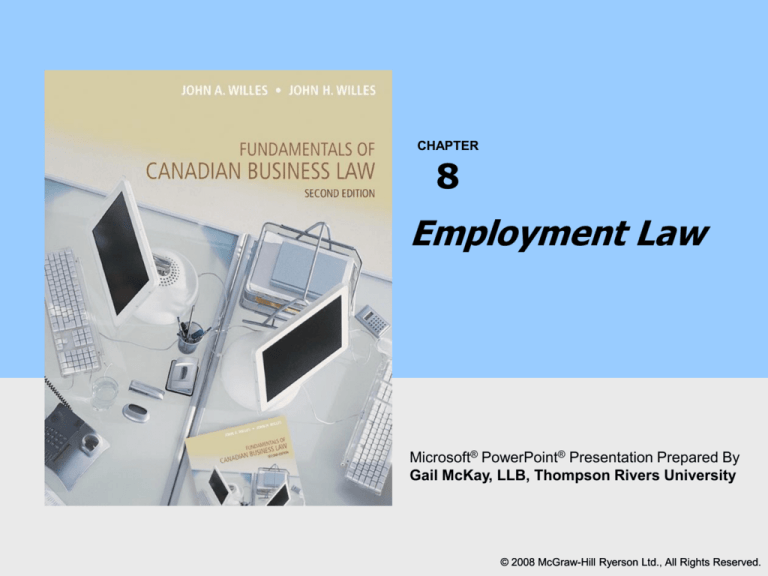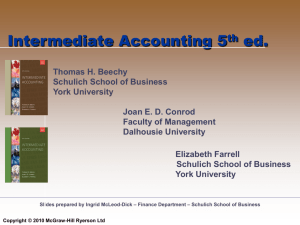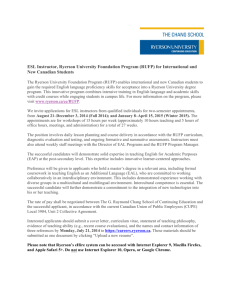
CHAPTER
8
Employment Law
Microsoft® PowerPoint® Presentation Prepared By
Gail McKay, LLB, Thompson Rivers University
© 2008 McGraw-Hill Ryerson Ltd.
Ltd., All Rights Reserved.
OBJECTIVES
1. To define what constitutes an employment
relationship
2. To delineate duties and responsibilities of
employers and of employees
3. To consider liability to third parties
4. To survey collective bargaining, the role of
unions, and the relationship between a
union and its members
Fundamentals of Canadian Business Law, Second Edition
© 2008 McGraw-Hill Ryerson Ltd. All Rights Reserved.
8-1
CONTRACT OF EMPLOYMENT
Having evolved from master-servant law,
employment law is now contractually based
The foundation of the contract, often of
indefinite duration, is the payment of wages for
the performance of services
If the employee will have access to confidential
employer information or company secrets, the
employee may be required to sign a restrictive
covenant preventing him or her from revealing
that information even after employment ends
Fundamentals of Canadian Business Law, Second Edition
© 2008 McGraw-Hill Ryerson Ltd. All Rights Reserved.
8-2
NATURE OF THE RELATIONSHIP
To distinguish between an employee and
independent contractor, a four part test asks
1. What degree of control is exercised over the
employee by the employer
2. Whose tools does the employee use
3. Who has the best chance to profit
4. Who takes the risk of loss
Fundamentals of Canadian Business Law, Second Edition
© 2008 McGraw-Hill Ryerson Ltd. All Rights Reserved.
8-3
INDEPENDENT CONTRACTORS
The organization test also helps distinguish
between employee and independent contractor
by asking is the person an integral part of the
employer’s business?
An independent contractor works by contract,
exercises discretion as to how the contract will
be accomplished, and may have employees of
his or her own
Fundamentals of Canadian Business Law, Second Edition
© 2008 McGraw-Hill Ryerson Ltd. All Rights Reserved.
8-4
COMPARISON: EMPLOYEE V. CONTRACTOR
The responsibilities of an employer are
higher for its employees in the following ways
1. Vicarious liability for actions of employees
2. Responsibility for payroll taxes and
remittances
3. Necessity for supervision of employees
4. Notice requirement for most dismissals
Fundamentals of Canadian Business Law, Second Edition
© 2008 McGraw-Hill Ryerson Ltd. All Rights Reserved.
8-5
DUTIES OF THE EMPLOYER
Statutes govern safety and working
conditions of the physical setting in which
employees perform, training in the use of
safety equipment necessary to meet
occupational health and safety standards and
the exposure of supervisors to liability for
breaches of health and safety statutes
Employment standards legislation governs the
terms of employment contracts and the
application of human rights law in hiring and
employment practices
Fundamentals of Canadian Business Law, Second Edition
© 2008 McGraw-Hill Ryerson Ltd. All Rights Reserved.
8-6
COMMON LAW STANDARDS
Over and above the statutory duties of
employers, there are implied common law
duties associated with compensation for
services as well as the indemnification for
expenditures or losses incurred by the
employee in the carrying out of his or her work
Further, employers must provide appropriate
tools or equipment; and if an employee is not
paid by salary, the employer must share the
formula used to calculate remuneration so the
employee can verify payments
Fundamentals of Canadian Business Law, Second Edition
© 2008 McGraw-Hill Ryerson Ltd. All Rights Reserved.
8-7
DUTIES OF THE EMPLOYEE
Employees owe both specified contractual
duties and implied employment duties to their
employers
Ordinary employees must obey reasonable
instructions, and perform at expected
standards and skills
But senior employees also owe a fiduciary duty
to their employer – one of utmost good faith,
placing the employer’s interest above their own
and not engaging in activities for secret profit
Fundamentals of Canadian Business Law, Second Edition
© 2008 McGraw-Hill Ryerson Ltd. All Rights Reserved.
8-8
CONFIDENTIALITY AGREEMENTS
If an employer may be vulnerable to
suffering a loss as a consequence of
confidential information which employees may
reveal to the public or to subsequent
employers, they may be required to sign a
confidentiality clause when they are hired
Types of confidential information include trade
secrets, client lists, marketing information, and
specific formulas or manufacturing techniques
Fundamentals of Canadian Business Law, Second Edition
© 2008 McGraw-Hill Ryerson Ltd. All Rights Reserved.
8-9
INFORMATION TECHNOLOGY ISSUES
An employers’ information technology
systems should be covered by operational
policies that lead to progressive discipline and
dismissal for abuses
Such policies should preclude an employee’s
harassment of others through company e-mail
accounts, an employee’s creation of a blog to
defame the employer, or the employee’s
hacking into unauthorized areas of employer
information
Fundamentals of Canadian Business Law, Second Edition
© 2008 McGraw-Hill Ryerson Ltd. All Rights Reserved.
8-10
TERMINATION OF EMPLOYMENT
Reasonable notice is required to terminate
an employment contract for a reason other
than just cause
Most provinces and territories have statutory
minimum notice periods relating to the
employee’s length of service
At common law, other factors may increase the
amount of notice required such as the age of
the employee, level of position in the company,
or availability of similar employment
Fundamentals of Canadian Business Law, Second Edition
© 2008 McGraw-Hill Ryerson Ltd. All Rights Reserved.
8-11
DISMISSAL FOR CAUSE
Dismissal without notice is permitted for a
serious breach of the employment contract, for
concurrence in a crime against the employer,
for insubordination, as well as for serious
incompetence or gross negligence
Dismissal for cause is also permitted for
disruption of the corporate culture, which is
employee behaviour that causes injury to the
employer because the employee treats clients
rudely or verbally abuses fellow employees
Fundamentals of Canadian Business Law, Second Edition
© 2008 McGraw-Hill Ryerson Ltd. All Rights Reserved.
8-12
WRONGFUL DISMISSAL
An employee can sue for wrongful
dismissal when he or she is dismissed without
cause and without reasonable notice
The employee is expected to attempt to
mitigate losses by seeking new employment
If the manner of dismissal is particularly
insensitive and callous or if false accusations
are made about the employee, damages for
mental distress may be added to the award of
damages for the wrongful dismissal
Fundamentals of Canadian Business Law, Second Edition
© 2008 McGraw-Hill Ryerson Ltd. All Rights Reserved.
8-13
CONSTRUCTIVE DISMISSAL
When an employee is demoted, without
consent, to a lower paying or undesirable
position, or an employee loses certain benefits
that were previously part of the employment
package, a court may find he or she has been
constructively dismissed
Although the usual remedy in most cases is
damages, Canada Labour Code provisions may
permit reinstatement of employees under its
jurisdiction
Fundamentals of Canadian Business Law, Second Edition
© 2008 McGraw-Hill Ryerson Ltd. All Rights Reserved.
8-14
EMPLOYER MISREPRESENTATION
Misrepresentation of a position at the time
of hiring may give rise to a lawsuit by an
employee for negligent misrepresentation
Losses that can be claimed include relocation
expenses and losses resulting from resignation
from the employee’s former job
It is important that recruitment personnel
avoid exaggeration of any aspects of the
position when dealing with applicants as a
result of this potential tort
Fundamentals of Canadian Business Law, Second Edition
© 2008 McGraw-Hill Ryerson Ltd. All Rights Reserved.
8-15
EMPLOYER LIABILITY TO THIRD PARTIES
Vicarious liability of an employer will arise
for the acts of employees which happen in the
course of their employment duties
The harm to third parties may occur either
through breach of contract or through
negligence by the employee
However, if the employee conduct falls outside
the scope of their normal employment duties,
the employer is not liable
Fundamentals of Canadian Business Law, Second Edition
© 2008 McGraw-Hill Ryerson Ltd. All Rights Reserved.
8-16
Fundamentals of Canadian Business Law, Second Edition
© 2008 McGraw-Hill Ryerson Ltd. All Rights Reserved.
8-17
COLLECTIVE BARGAINING
Collective bargaining legislation is a type of
law in which a group of employees negotiate
the terms of their employment contract
(collective agreement) through a union
The union acquires an exclusive right to
represent the group of employees through a
certification process
A negotiation process is the next step, when a
union notifies an employer that it wishes to
bargain for a collective agreement
Fundamentals of Canadian Business Law, Second Edition
© 2008 McGraw-Hill Ryerson Ltd. All Rights Reserved.
8-18
THIRD APRTY INTERVENTION
Conciliation to identify issues, mediation to
attempt to resolve disputes, and fact finding to
isolate issues and report findings to a
government body are all third party methods
of attempting to resolve problems during the
process of a negotiation
A strike is a legal cessation of work by
employees, whereas a lockout is an employer’s
refusal to permit employees onto its premises
– both being powerful tactics used during the
collective bargaining negotiation
Fundamentals of Canadian Business Law, Second Edition
© 2008 McGraw-Hill Ryerson Ltd. All Rights Reserved.
8-19
COMPULSORY ARBITRATION
Essential services employees are required
to enter compulsory arbitration when
negotiations break down
An arbitration board is established to hear
disputes and render decisions that are binding
on the parties
Non essential services may also use
compulsory arbitration to settle disputes in
cases where strikes or lockouts are lengthy
Fundamentals of Canadian Business Law, Second Edition
© 2008 McGraw-Hill Ryerson Ltd. All Rights Reserved.
8-20
ADMINSTRATION OF THE AGREEMENT
Along with the rights and duties of
employer and employee, the collective
agreement specifies the rights and duties of
the union as well, in particular the right of the
union to act as exclusive bargaining agent for
the bargaining unit of employees
When there is an issue with an employer, the
union brings a grievance on the employees’
behalf which, if unresolved, can then be
brought to arbitration for a decision
Fundamentals of Canadian Business Law, Second Edition
© 2008 McGraw-Hill Ryerson Ltd. All Rights Reserved.
8-21
Fundamentals of Canadian Business Law, Second Edition
© 2008 McGraw-Hill Ryerson Ltd. All Rights Reserved.
8-22
THE UNION-MEMBERSHIP RELATIONSHIP
Union membership may be a requirement
which cannot be refused in certain types of
employment
There is a duty of fair representation on a
union to represent members not only
collectively but also individually
They are required to act in good faith and in a
non arbitrary, non discriminatory manner, but
may deny the arbitration of a grievance if, in
their assessment, it should not proceed
Fundamentals of Canadian Business Law, Second Edition
© 2008 McGraw-Hill Ryerson Ltd. All Rights Reserved.
8-23
SUMMARY
To distinguish between an employee and an
independent contractor, the control test or
organization test may be applied
Employers and employees each have duties
under their contract of employment; dismissal
for cause may result when an employee is in
breach; wrongful or constructive dismissal
actions may result if the employer is in breach
Collective bargaining legislation governs the
relationship between unions and employers
Fundamentals of Canadian Business Law, Second Edition
© 2008 McGraw-Hill Ryerson Ltd. All Rights Reserved.
8-24




